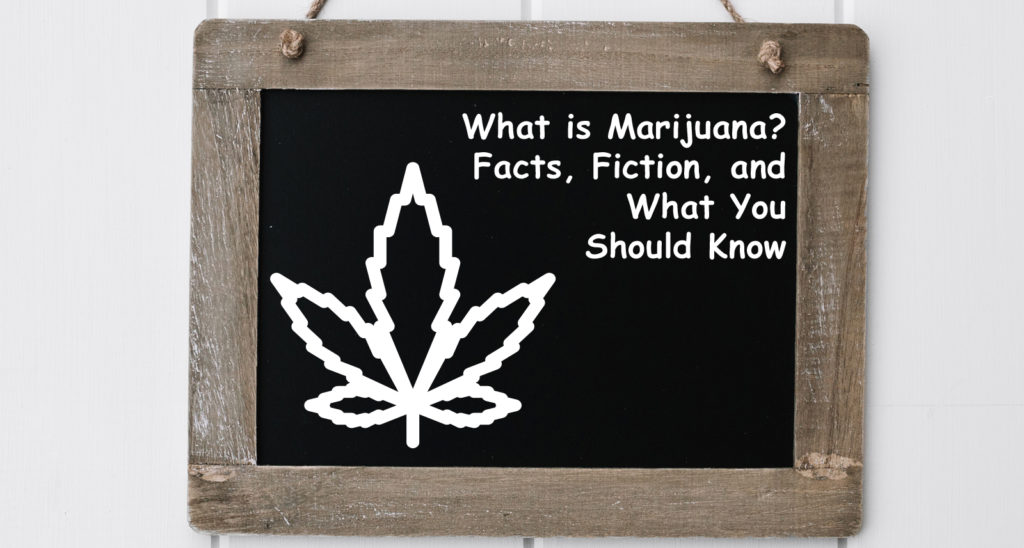The simplest answer to “what is marijuana” is that it is a plant. When the leaves or flowers are dried, they can be smoked or used to make products that create chemical changes in the body. That’s the simple answer. In truth, there is a lot more to cannabis, the technical name for marijuana. Marijuana is also the most commonly used illicit in the U. S. According to the National Institute on Drug Abuse (NIDA), more than 11 million young adults, aged 18-25, used marijuana in 2015. There’s also a long history of cannabis use as medicine. Due to legal restrictions, research studies supporting use of marijuana or its components are still woefully inadequate. Like all drugs, weed use carries significant risks to the user’s health too.
Science’s answer to what is marijuana
Marijuana is the common name for portions of the cannabis plant. Marijuana has many slang names; most common are weed, pot, Mary Jane, and ganja. As it turns out there are three species of cannabis: cannabis sativa, cannabis indica, and cannabis ruderalis. Each variety has its characteristics that change the way the brain works. Humans have been smoking, making tea from, and crafting medicine from cannabis for thousands of years.
Pot as a drug or medicine
Scientists believe that two active ingredients found in marijuana are responsible for the effects marijuana has on the human body. These two chemicals are tetrahydrocannabinol, also known as THC, and cannabidiol, known as CBD. THC has psychoactive properties that impact mood and perception in the brain. CBD is believed to offer many medical benefits without the “high” or euphoric effect of THC. Researchers are optimistic regarding the potential medicinal value of CBD. Legal drugs containing CBD have already been approved by the FDA, primarily for the treatment of some forms of epilepsy. There is still much to study and learn when it comes to medical uses for cannabis and its chemical components. While research on the medical use of marijuana is in its infancy, scientists believe some of the other chemicals within cannabis may also hold medicinal value including THCA, CBN, and CBC. Weed is still illegal in the United States. This fact has historically limited research on marijuana. The legalization for medicinal use in many states has had a positive impact on research as drug companies seek to find new patentable medications.
How is marijuana consumed
There are four primary ways people ingest marijuana: inhalation, oral, topical (on the skin), and sublingual.
Inhalation
The most common way to use marijuana is to inhale the smoke from the flowers or leaves. The cannabinoids inhaled through the lungs reach the bloodstream instantly. People generally feel its effects within a few minutes. Smokers may use a pipe, home-rolled cigarettes, or a water pipe. Unfortunately hot smoke is harmful to the mouth, throat, and lungs. A popular alternative to smoking is vaping. When pot is smoked, the leaves are burned and the smoke inhaled. Vaping heats the leaves to release a vapor instead of smoke. This reduces irritation to your throat and lungs. However, studies have not yet concluded if oil based vaporizers are safer. THC levels are usually higher in oils, which can create health and mental problems for novices. The ingredients used to create oils can leave a residue with its own hazards. More testing is needed to determine if oils are indeed safe.
Oral and sublingual
Marijuana can be consumed by mouth. This usually takes the form of food products made with cannabis. These are known as “edibles.” Oils or tinctures are also available. It takes 30 minutes to an hour to feel the effects, but the effects are generally stronger. The delayed effect makes it easier to consume too much. Sublingual means that you are placing something under the tongue so the body can absorb it. This is accomplished using sprays, dissolvable strips, tinctures, or lozenges. This may, or may not, result in feeling the effects faster than by other oral methods.
Topical
An assortment of lotions, oils, salves, and bath salts have entered the market. These products allow for the absorption of the chemicals through the skin. Topical agents are used for localized pain relief and have the benefit of not delivering the psychoactive effects of THC to the brain.
Marijuana’s effects on the brain
The most commonly known effects of marijuana use are the psychoactive and euphoric effects on the brain. This effect is caused by the THC found within certain strains of the plant. Researchers are studying the how THC may impact some illnesses including cancer and Multiple Sclerosis; as well as its effect on pain. 20 years ago, scientists identified areas in the brain known as cannabinoid (CB) receptors. Cannabinoids regulate how the brain sends, receives and processes information, slowing down the communication between cells. The body naturally produces its own chemicals that act on these receptors – Anandamide and 2-arachidonoyl glycerol. These two chemicals, along with the receptors form what is known as the endocannabinoid (EC) system.
How does THC effect the EC system?
If a person smokes marijuana, THC moves quickly into the brain, attaching to the cannabinoid receptors. Unfortunately, THC overwhelms the EC system and prevents the natural cannabinoids in your brain from working properly. This can impact different parts of your brain and cause a variety of changes, not all of them good. To begin with, weed slows your reaction time. This can be especially dangerous if you’re driving a car or operating machinery. That’s one reason why all U. S. States prohibit driving under the influence of marijuana. Other effects of THC are a mixed bag of good effects like reducing pain, nausea and increasing the appetite for critically ill patients, and bad effects like impaired memory function, panic or paranoia, and negative changes in judgment and thinking. Dangerous, mind-altering, side effects at higher doses can include delusions, hallucinations, and psychosis.
Long-term health effects
Don’t kid yourself, legal or not; cannabis is a drug that can cause both mental health and other health problems. Research is still underway to determine which negative changes are permanent. The long-term effects of cannabis are especially dangerous to those who begin use as teenagers when the brain is still under development. Marijuana interferes with the way the brain builds connections between the areas of the brain. These connections are vital to the way you think, your emotions, and other health processes. One research study showed that people who start smoking weed as teens lost an average of 8 IQ points between ages 13 and 38. This loss was never fully recovered even after they stopped using. NIDA is currently studying the consequences of pot use to learn more about how, and to what extent, extended use harms the brain and body.
Risks to the body
Cannabis’s effects on the brain are well-known. However, many users are unaware of other negative health effects. Additional health risks include:
Breathing problems
Just as with cigarettes, if you’re inhaling hot smoke on a regular basis, you are doing damage to your lungs and throat. These risks include frequent lung illnesses, coughing and mucus, and a higher risk of infections such as bronchitis or pneumonia.
Intense nausea and vomiting
Marijuana helps reduce nausea for those undergoing chemotherapy, but those that engage in frequent and long-term use are a risk of contracting Cannabinoid Hyperemesis Syndrome (CHS). CHS causes regular cycles of vomiting and severe nausea, that may require emergency treatment.
Abnormal heart rate
Marijuana can increase the heart rate for up to 3 hours after use. This may bring on a heart attack. Those with heart problems or who are elderly are at greater risk.
Risks in pregnancy
Due to the popularity of use to reduce nausea, cannabis use during pregnancy is common. One study found that 1 in 5 pregnant women under 25 tested positive for marijuana. There is no research suggesting that it is safe to use pot while pregnant. Current research suggests the opposite. However, medical experts warn against the use of all forms of pot during pregnancy. There is concern that use while pregnant is linked to lower birth weights and an increase in premature births. That puts your baby’s health at risk. Research indicated that women who use cannabis during pregnancy have a 2.3 times greater chance of having a stillbirth. Research has already shown that marijuana use harms the developing brain. The American College of Obstetricians and Gynecologists strongly recommends that women who are pregnant, trying to get pregnant, or breastfeeding avoid cannabis use and exposure. For more information on how weed can affect pregnancy, read NIDA’s Marijuana Research Report.
Rising THC levels bring additional concerns
Over the past few decades, the level of THC found in cannabis has been rising. This brings additional health risks to the user. As a result, emergency room visits following marijuana use have been rising. Additionally, edibles, food products made with cannabis extract, increase the likelihood of a bad reaction. Edibles take longer to digest, so it’s easy to over-indulge. Higher THC levels also create a higher risk of addiction when people choose to use regularly.
Mental health risks
Cannabis users are also at risk for mental illness. Use has been linked to temporary bouts of paranoia and hallucinations. It’s known to worsen the symptoms of schizophrenia. Marijuana use has been associated with other mental disorders including depression, anxiety, and suicidal thoughts in teens.
Employment risk
So far we’ve discussed what marijuana can do to your body. However, pot use can also risk your ability to obtain and hold a job. It is extremely common for employers to require applicants pass a drug test as a condition for employment. This is true even in states that have legalized pot use. In addition to pre-employment testing, some employers perform random testing, and test employees injured at work. A positive screen can result in job termination or result in a denial of workers compensation coverage. The THC can remain in your body for a month or more, depending on how much, and how often, you use it. This means you can fail a drug test for weeks after you stop.
Can you overdose?
An overdose is possible when a person consumes too much of any substance. The real question here is whether or not an overdose is life-threatening. Pot alone does not cause death directly. However, an overdose can result in serious and uncomfortable side effects. As stated above, too much THC can bring on paranoia and anxiety, or even a psychotic reaction.
Is marijuana addictive?
One of the reasons marijuana use is so common is the incorrect believe that it is not addictive. Cannabis can absolutely lead to a substance abuse disorder, where the individual is unable to stop using despite negative health or social problems. Studies have demonstrated that up to 30% of users develop a substance abuse disorder. The younger someone starts to use, the greater the risk of developing an addiction. Those who start before age 18 are 4-7 times more likely to become addicted. Individuals who are addicted to marijuana may require the help of addiction professionals to end their addiction. References: https://www.livescience.com/24559-marijuana-facts-cannabis.html https://news.lift.co/anatomy-cannabis-5-components-need-know/ http://headsup.scholastic.com/students/the-science-of-marijuana https://www.drugabuse.gov/publications/drugfacts/marijuana https://www.drugabuse.gov/publications/research-reports/marijuana/can-marijuana-use-during-pregnancy-harm-baby http://www.drugpolicy.org/drug-facts/10-facts-about-marijuana/how-marijuana-consumed


